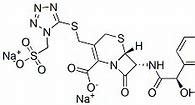Physicochemical Properties
| Molecular Formula | C18H16N6NA2O8S3 |
| Molecular Weight | 586.53 |
| Exact Mass | 585.998 |
| Elemental Analysis | C, 36.86; H, 2.75; N, 14.33; Na, 7.84; O, 21.82; S, 16.40 |
| CAS # | 61270-78-8 |
| Related CAS # | 190181-58-9 (disodium);61270-78-8 (sodium);61270-58-4 (free);71420-79-6 (monosodium); |
| PubChem CID | 43593 |
| Appearance | White to off-white solid powder |
| Melting Point | > 160ºC |
| Hydrogen Bond Donor Count | 2 |
| Hydrogen Bond Acceptor Count | 13 |
| Rotatable Bond Count | 7 |
| Heavy Atom Count | 37 |
| Complexity | 980 |
| Defined Atom Stereocenter Count | 3 |
| SMILES | S1C([H])([H])C(C([H])([H])SC2=NN=NN2C([H])([H])S(=O)(=O)[O-])=C(C(=O)[O-])N2C([C@]([H])([C@@]12[H])N([H])C([C@@]([H])(C1C([H])=C([H])C([H])=C([H])C=1[H])O[H])=O)=O.[Na+].[Na+] |
| InChi Key | NAXFZVGOZUWLEP-RFXDPDBWSA-L |
| InChi Code | InChI=1S/C18H18N6O8S3.2Na/c25-13(9-4-2-1-3-5-9)14(26)19-11-15(27)24-12(17(28)29)10(6-33-16(11)24)7-34-18-20-21-22-23(18)8-35(30,31)32;;/h1-5,11,13,16,25H,6-8H2,(H,19,26)(H,28,29)(H,30,31,32);;/q;2*+1/p-2/t11-,13-,16-;;/m1../s1 |
| Chemical Name | disodium;(6R,7R)-7-[[(2R)-2-hydroxy-2-phenylacetyl]amino]-8-oxo-3-[[1-(sulfonatomethyl)tetrazol-5-yl]sulfanylmethyl]-5-thia-1-azabicyclo[4.2.0]oct-2-ene-2-carboxylate |
| Synonyms | Cefonicid Sodium; Monocid; Cefonicid disodium salt; SK&F D-75073-Z2; UNII-F74MFL78A1; CHEBI:3492; SKF-75073-2; SKF750732; Cefonicid, Sodium; Monocid; |
| HS Tariff Code | 2934.99.9001 |
| Storage |
Powder-20°C 3 years 4°C 2 years In solvent -80°C 6 months -20°C 1 month Note: Please store this product in a sealed and protected environment (e.g. under nitrogen), avoid exposure to moisture and light. |
| Shipping Condition | Room temperature (This product is stable at ambient temperature for a few days during ordinary shipping and time spent in Customs) |
Biological Activity
| Targets | β-lactam |
| References |
[1]. Cefonicid. A review of its antibacterial activity, pharmacological properties and therapeutic use. Drugs. 1986 Sep;32(3):222-59. [2]. Review of cefonicid, a long-acting cephalosporin. Clin Pharm. 1984 Jan-Feb;3(1):23-32. |
| Additional Infomation |
Cefonicid sodium is an organic sodium salt. It contains a cefonicid(2-). Cefonicid Sodium is the sodium salt form of cefonicid, a semisynthetic second-generation cephalosporin with antibacterial activity. Cefonicid binds to and inactivates penicillin-binding proteins (PBPs) located on the inner membrane of the bacterial cell wall. PBPs are enzymes involved in the terminal stages of assembling the bacterial cell wall and in reshaping the cell wall during growth and division. Inactivation of PBPs interferes with the cross-linkage of peptidoglycan chains necessary for bacterial cell wall strength and rigidity. This results in the weakening of the bacterial cell wall and causes cell lysis. A second-generation cephalosporin administered intravenously or intramuscularly. Its bactericidal action results from inhibition of cell wall synthesis. It is used for urinary tract infections, lower respiratory tract infections, and soft tissue and bone infections. See also: Cefonicid (has active moiety). |
Solubility Data
| Solubility (In Vitro) |
DMSO : ~125 mg/mL (~213.12 mM) H2O : ~100 mg/mL (~170.49 mM) |
| Solubility (In Vivo) |
Solubility in Formulation 1: ≥ 2.5 mg/mL (4.26 mM) (saturation unknown) in 10% DMSO + 40% PEG300 + 5% Tween80 + 45% Saline (add these co-solvents sequentially from left to right, and one by one), clear solution. For example, if 1 mL of working solution is to be prepared, you can add 100 μL of 25.0 mg/mL clear DMSO stock solution to 400 μL PEG300 and mix evenly; then add 50 μL Tween-80 to the above solution and mix evenly; then add 450 μL normal saline to adjust the volume to 1 mL. Preparation of saline: Dissolve 0.9 g of sodium chloride in 100 mL ddH₂ O to obtain a clear solution. Solubility in Formulation 2: ≥ 2.5 mg/mL (4.26 mM) (saturation unknown) in 10% DMSO + 90% (20% SBE-β-CD in Saline) (add these co-solvents sequentially from left to right, and one by one), clear solution. For example, if 1 mL of working solution is to be prepared, you can add 100 μL of 25.0 mg/mL clear DMSO stock solution to 900 μL of 20% SBE-β-CD physiological saline solution and mix evenly. Preparation of 20% SBE-β-CD in Saline (4°C,1 week): Dissolve 2 g SBE-β-CD in 10 mL saline to obtain a clear solution. Solubility in Formulation 3: ≥ 2.5 mg/mL (4.26 mM) (saturation unknown) in 10% DMSO + 90% Corn Oil (add these co-solvents sequentially from left to right, and one by one), clear solution. For example, if 1 mL of working solution is to be prepared, you can add 100 μL of 25.0 mg/mL clear DMSO stock solution to 900 μL of corn oil and mix evenly. Solubility in Formulation 4: 10% DMSO+40% PEG300+5% Tween-80+45% Saline: ≥ 2.5 mg/mL (4.26 mM) Solubility in Formulation 5: 100 mg/mL (170.49 mM) in PBS (add these co-solvents sequentially from left to right, and one by one), clear solution; with ultrasonication. (Please use freshly prepared in vivo formulations for optimal results.) |
| Preparing Stock Solutions | 1 mg | 5 mg | 10 mg | |
| 1 mM | 1.7049 mL | 8.5247 mL | 17.0494 mL | |
| 5 mM | 0.3410 mL | 1.7049 mL | 3.4099 mL | |
| 10 mM | 0.1705 mL | 0.8525 mL | 1.7049 mL |
